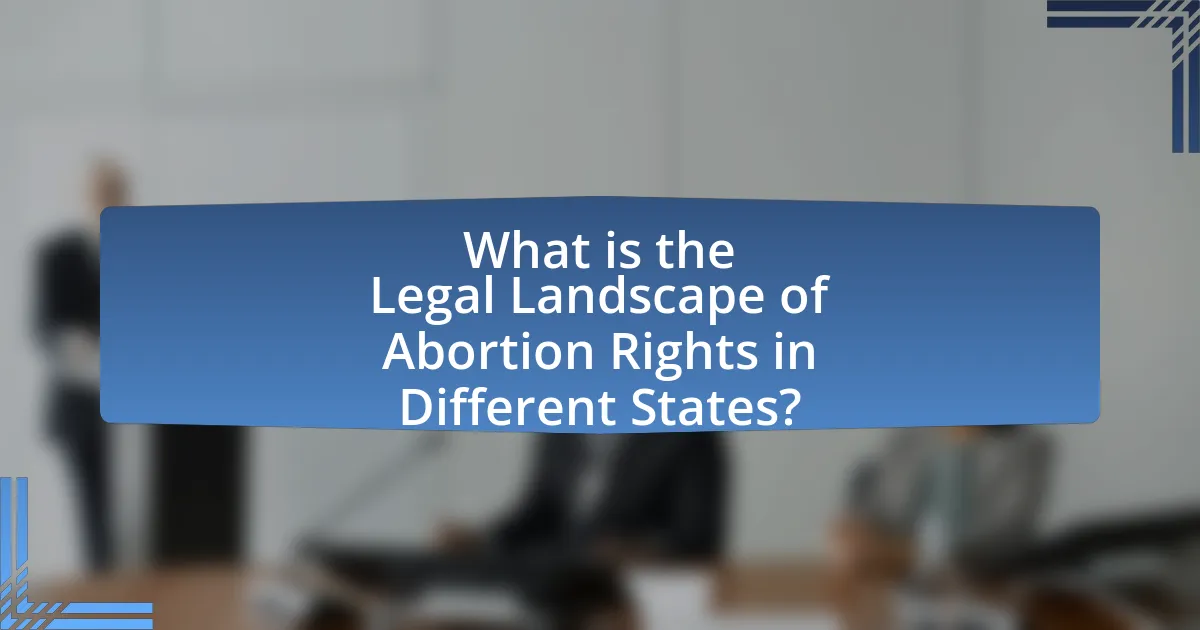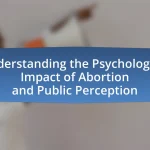The article examines the legal landscape of abortion rights across various states in the United States, highlighting the significant disparities in legislation. It details how states like Texas and Alabama have enacted restrictive abortion laws, while states such as California and New York maintain strong protections for reproductive rights. Key factors influencing these laws include political ideology, public opinion, and the composition of state legislatures. The article also discusses the historical context of abortion rights, the impact of landmark Supreme Court cases, and the implications of state-level regulations on women’s health and access to safe abortion services. Additionally, it provides resources for individuals navigating the complex legal environment surrounding abortion rights.

What is the Legal Landscape of Abortion Rights in Different States?
The legal landscape of abortion rights in different states varies significantly, with some states enacting restrictive laws while others maintain more liberal access. For instance, as of 2023, states like Texas and Alabama have implemented stringent abortion bans, often with limited exceptions, reflecting a trend towards increased restrictions following the Supreme Court’s decision in Dobbs v. Jackson Women’s Health Organization. Conversely, states such as California and New York uphold strong protections for abortion rights, ensuring access through state legislation that safeguards reproductive health services. This divergence illustrates the complex and evolving nature of abortion laws across the United States, influenced by political, social, and judicial factors.
How do state laws vary regarding abortion rights?
State laws regarding abortion rights vary significantly across the United States, with some states enacting restrictive measures while others protect access to abortion. For instance, states like Texas and Alabama have implemented laws that severely limit abortion access, including mandatory waiting periods and gestational limits, while states such as California and New York have laws that safeguard the right to choose and expand access to reproductive health services. According to the Guttmacher Institute, as of 2023, 13 states have enacted total bans on abortion, while 16 states have laws that protect the right to abortion without significant restrictions. This variation reflects differing political, cultural, and social attitudes towards reproductive rights across the country.
What are the key factors influencing state-level abortion legislation?
Key factors influencing state-level abortion legislation include political ideology, public opinion, and the composition of state legislatures. Political ideology shapes the values and priorities of lawmakers, with conservative states typically enacting more restrictive laws, while liberal states tend to support broader access. Public opinion also plays a crucial role; states with higher support for abortion rights often see legislation that reflects this sentiment. Additionally, the composition of state legislatures, including the number of women and minority representatives, can impact the types of abortion laws proposed and passed. For instance, states with a majority of female legislators are more likely to advocate for reproductive rights, as evidenced by data from the Center for American Women and Politics.
How do cultural and political climates affect abortion laws in states?
Cultural and political climates significantly influence abortion laws in states by shaping public opinion and legislative priorities. For instance, states with conservative cultural values often enact stricter abortion regulations, reflecting the beliefs of their constituents, while more liberal states tend to support broader access to abortion services. A clear example is Texas, where a conservative political climate has led to the implementation of restrictive laws, such as the 2021 Senate Bill 8, which bans most abortions after six weeks. Conversely, states like California have adopted laws that protect and expand abortion access, demonstrating how progressive political leadership aligns with cultural attitudes favoring reproductive rights. This dynamic illustrates the direct correlation between the prevailing cultural and political environments and the legal frameworks governing abortion in various states.
What historical context shapes current abortion rights in the U.S.?
The historical context that shapes current abortion rights in the U.S. includes landmark Supreme Court decisions, legislative actions, and social movements. The 1973 Supreme Court ruling in Roe v. Wade established a woman’s legal right to choose abortion, asserting that the right to privacy under the Due Process Clause of the 14th Amendment extends to a woman’s decision to terminate her pregnancy. This decision set a precedent that influenced subsequent legal battles and state laws regarding abortion. Additionally, the 1992 case of Planned Parenthood v. Casey reaffirmed Roe v. Wade while allowing states to impose certain restrictions, reflecting ongoing debates about abortion rights. Over the years, various states have enacted laws that either protect or restrict access to abortion, influenced by shifting political landscapes and public opinion. These historical developments continue to impact the legal framework surrounding abortion rights today.
How did landmark Supreme Court cases influence state abortion laws?
Landmark Supreme Court cases significantly influenced state abortion laws by establishing constitutional protections for abortion rights. The 1973 case Roe v. Wade recognized a woman’s right to choose an abortion under the right to privacy, effectively invalidating many state laws that restricted access to abortion. This ruling set a legal precedent that states could not impose undue burdens on a woman’s right to terminate her pregnancy. Subsequent cases, such as Planned Parenthood v. Casey in 1992, reaffirmed Roe while allowing states to implement certain regulations, as long as they did not place an “undue burden” on women seeking abortions. These decisions have led to a patchwork of state laws, with some states enacting restrictive measures and others maintaining broader access, reflecting the ongoing legal and political debates surrounding abortion rights.
What role did the Roe v. Wade decision play in shaping abortion rights?
The Roe v. Wade decision established a constitutional right to abortion, fundamentally shaping abortion rights in the United States. This landmark 1973 Supreme Court ruling recognized a woman’s right to privacy under the Due Process Clause of the 14th Amendment, which extended to her decision to terminate a pregnancy. The ruling invalidated many state laws that restricted access to abortion, effectively legalizing it nationwide during the first trimester and setting a framework for subsequent regulations. Roe v. Wade has since served as a pivotal precedent in legal battles over abortion rights, influencing legislation and court decisions across various states, and has been cited in numerous cases regarding reproductive rights.
What are the current trends in abortion legislation across states?
Current trends in abortion legislation across states indicate a significant polarization, with some states enacting restrictive laws while others are expanding access. For instance, states like Texas and Alabama have implemented stringent abortion bans, often with limited exceptions, reflecting a trend towards increased restrictions. Conversely, states such as California and New York are enhancing protections for abortion rights, including measures to safeguard access and funding for reproductive health services. This divergence is influenced by political leadership, public opinion, and recent Supreme Court rulings, particularly the overturning of Roe v. Wade, which has empowered states to set their own abortion policies.
Which states have recently enacted restrictive abortion laws?
Several states have recently enacted restrictive abortion laws, including Texas, Florida, and Alabama. Texas implemented a law in 2021 that bans most abortions after six weeks of pregnancy, while Florida passed a law in 2022 that restricts abortions after 15 weeks. Alabama’s law, enacted in 2019, effectively bans nearly all abortions, with very limited exceptions. These legislative actions reflect a significant shift in the legal landscape surrounding abortion rights in these states.
How are states responding to changes in federal abortion policies?
States are responding to changes in federal abortion policies by enacting a range of laws that either restrict or protect access to abortion services. For instance, following the Supreme Court’s decision in Dobbs v. Jackson Women’s Health Organization, which overturned Roe v. Wade, many states with pre-existing trigger laws quickly implemented bans on abortion, while others have moved to codify abortion rights into state law. According to the Guttmacher Institute, as of October 2023, 13 states have enacted total bans on abortion, while several others have expanded access through legislative measures or ballot initiatives. This divergence illustrates how state governments are actively shaping the legal landscape of abortion rights in response to federal policy changes.
How do different states regulate abortion procedures?
Different states regulate abortion procedures through a variety of laws that dictate the conditions under which abortions can be performed. For instance, some states impose gestational limits, requiring abortions to occur within a specific timeframe, often around six to twenty weeks of pregnancy. Additionally, states may mandate waiting periods, parental consent for minors, and counseling requirements before the procedure.
For example, Texas has implemented a law that bans most abortions after six weeks, while California allows abortions up to the point of viability, which is generally around 24 weeks. Furthermore, states like Alabama have enacted near-total bans on abortion, with few exceptions, while others, such as New York, have expanded access and protections for abortion rights. These regulations reflect the diverse legal landscape across the United States, influenced by political, cultural, and social factors.
What are the common requirements for obtaining an abortion in various states?
Common requirements for obtaining an abortion in various states include parental consent for minors, mandatory waiting periods, and counseling sessions. For instance, many states require individuals under 18 to obtain consent from a parent or guardian, while others mandate a waiting period of 24 to 72 hours after an initial consultation before the procedure can be performed. Additionally, some states require patients to undergo counseling to receive information about the procedure and alternatives. These regulations vary significantly across states, reflecting differing legal frameworks and cultural attitudes toward abortion.
How do waiting periods and parental consent laws differ by state?
Waiting periods and parental consent laws for abortion vary significantly by state. For instance, some states require a waiting period of 24 to 72 hours after a consultation before an abortion can be performed, while others have no waiting period at all. Additionally, parental consent laws differ; some states mandate that minors obtain consent from one or both parents, while others allow minors to seek a judicial bypass to avoid parental notification. According to the Guttmacher Institute, as of 2023, 27 states enforce a waiting period, and 37 states require parental involvement in a minor’s decision to have an abortion.
What are the implications of state-level abortion rights on women’s health?
State-level abortion rights significantly impact women’s health by influencing access to safe and legal abortion services. When states impose restrictive abortion laws, such as mandatory waiting periods or gestational limits, women’s ability to obtain timely care diminishes, leading to potential health risks. Research indicates that states with more restrictive abortion laws experience higher rates of maternal morbidity and mortality, as women may resort to unsafe methods or delay necessary medical care. For instance, a study published in the American Journal of Public Health found that women in states with stringent abortion regulations faced a 50% higher risk of complications compared to those in states with fewer restrictions. Thus, the implications of state-level abortion rights directly correlate with women’s health outcomes, emphasizing the importance of access to comprehensive reproductive healthcare.
How do restrictions impact access to safe abortion services?
Restrictions significantly limit access to safe abortion services by imposing legal barriers that can include mandatory waiting periods, parental consent laws, and gestational limits. These restrictions often lead to increased travel distances to clinics, higher costs, and delays in obtaining services, which can exacerbate health risks. For instance, a study published in the American Journal of Public Health found that states with more restrictive abortion laws saw a 20% increase in the likelihood of women seeking unsafe abortion methods. Additionally, the Guttmacher Institute reports that such restrictions disproportionately affect low-income individuals and marginalized communities, further widening health disparities.
What are the potential health risks associated with limited abortion access?
Limited abortion access can lead to significant health risks, including increased maternal mortality and morbidity. Research indicates that regions with restrictive abortion laws often experience higher rates of unsafe abortions, which can result in severe complications such as infection, hemorrhage, and long-term reproductive health issues. For instance, a study published in the Lancet found that countries with highly restrictive abortion laws have maternal mortality rates that are 14 times higher than those in countries where abortion is broadly legal. Additionally, limited access can exacerbate mental health issues, as individuals may face increased anxiety and depression due to unwanted pregnancies and lack of support.
How can individuals navigate the legal landscape of abortion rights?
Individuals can navigate the legal landscape of abortion rights by researching state-specific laws and regulations regarding abortion access. Each state has different legal frameworks that govern abortion, influenced by recent legislative changes and court rulings. For instance, as of 2023, some states have enacted restrictive laws, while others maintain protections for abortion rights, reflecting the ongoing legal battles and public policy debates. Accessing resources from organizations such as the Guttmacher Institute or Planned Parenthood can provide updated information on the legal status of abortion in each state, including any recent changes or pending legislation.
What resources are available for understanding state-specific abortion laws?
Comprehensive resources for understanding state-specific abortion laws include the Guttmacher Institute, which provides detailed state-by-state analyses of abortion policies, and the Center for Reproductive Rights, offering legal information and updates on abortion rights across the United States. Additionally, the National Abortion Federation maintains a directory of state laws and regulations, while the American Civil Liberties Union (ACLU) provides resources on legal challenges and advocacy efforts related to abortion rights. These organizations compile data, legal texts, and analyses that are essential for grasping the complexities of abortion laws in each state.
How can advocacy groups assist individuals seeking abortion services?
Advocacy groups assist individuals seeking abortion services by providing essential resources, information, and support tailored to the legal landscape of abortion rights in different states. These organizations often offer services such as legal advice, financial assistance for travel and procedures, and connections to healthcare providers who perform abortions. For instance, the National Abortion Federation provides a hotline that helps individuals locate nearby clinics and understand their rights, while organizations like Planned Parenthood offer educational resources about the abortion process and state-specific laws. Additionally, advocacy groups engage in lobbying efforts to influence legislation and protect access to abortion services, which is crucial given the varying legal restrictions across states.


